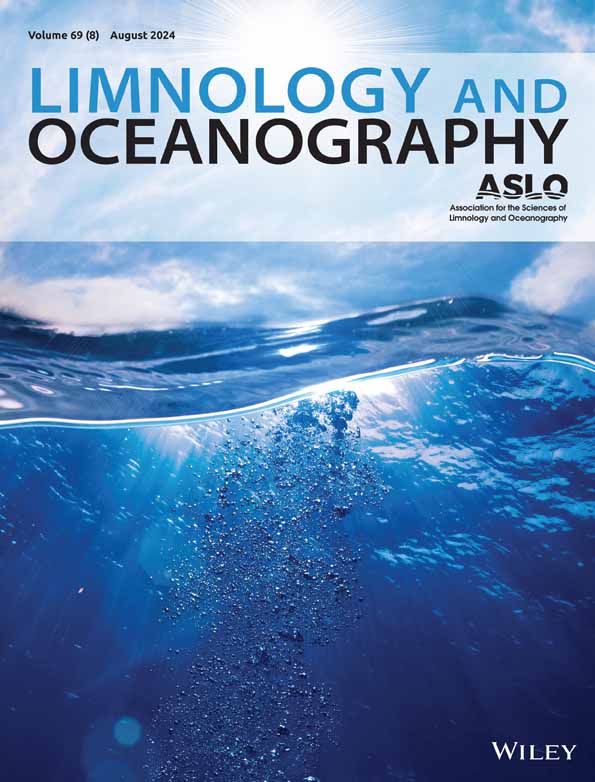两种用于恢复的中胚层八爪珊瑚的生态生理学:光和温度的影响
IF 3.7
1区 地球科学
Q1 LIMNOLOGY
引用次数: 0
摘要
光和温度是塑造中叶藻生物进化和生理的驱动力。在密西西比-阿拉巴马大陆架上,八爪珊瑚主导着中层海洋景观,并为许多鱼类和无脊椎动物物种提供栖息地。关于这些物种对光和温度的基本生理反应的知识差距对深水地平线漏油事件后的恢复活动特别感兴趣。为了解决这些空白,我们在田间和实验室对臭臭霉和臭臭霉的光生物学和耐热性进行了评估。脉冲振幅调制荧光法、组织学、光镜和荧光成像显示,在靠近确定的光带底部(51.45 m)处采集的S. exserta样品中光合内生生物密度低,而m . pendula样品中没有光合内生生物密度。利用呼吸测量法和暴露在18°C至26°C温度下的活珊瑚的珊瑚虫活动数据,评估对记录的每月平均栖息地温度范围(18.5-25.4°C)的反应。在18°C和26°C之间,两种植物的耗氧量没有显著差异,计算的Q10值与1没有显著差异,表明两种植物对当地热环境的敏感性较低。然而,温度与息肉活性之间的负相关表明,M. pendula比S. exserta对更高的温度更敏感。本研究提高了对光和温度对中叶八珊瑚虫生理影响的认识,为进一步探索各物种的热阈值和内寄主关系奠定了基础。本文章由计算机程序翻译,如有差异,请以英文原文为准。
Ecophysiology of two mesophotic octocorals intended for restoration: Effects of light and temperature
Light and temperature are driving forces that shape the evolution and physiology of mesophotic organisms. On the Mississippi‐Alabama continental shelf, octocorals dominate the mesophotic seascape and provide habitat for many fish and invertebrate species. Gaps in knowledge regarding the fundamental physiological responses of these species to light and temperature are of particular interest to restoration activities following the Deepwater Horizon oil spill. To address these gaps, the photobiology and thermal tolerance of Swiftia exserta and Muricea pendula were assessed in the field and laboratory. Pulse amplitude modulated fluorometry, histology, light microscopy, and epifluorescence imaging revealed low densities of photosynthetic endobionts in samples of S. exserta and none in samples of M. pendula collected near the determined bottom of the euphotic zone (51.45 m). Response to the recorded monthly mean habitat temperature range (18.5–25.4°C) was assessed using respirometry and polyp activity data from live corals exposed to temperatures between 18°C and 26°C. There was no significant difference in oxygen consumption for either species between 18°C and 26°C, and calculated Q 10 values were not significantly different from 1, thus suggesting that both species have a low sensitivity to the local thermal environment. However, a negative correlation between temperature and polyp activity suggests that M. pendula is more sensitive to higher temperatures than S. exserta . This study improves the understanding of the effects of light and temperature on mesophotic octocoral physiology and lays the foundation for future work to explore the thermal thresholds of each species and the endobiont–host relationship in S. exserta .
求助全文
通过发布文献求助,成功后即可免费获取论文全文。
去求助
来源期刊

Limnology and Oceanography
地学-海洋学
CiteScore
8.80
自引率
6.70%
发文量
254
审稿时长
3 months
期刊介绍:
Limnology and Oceanography (L&O; print ISSN 0024-3590, online ISSN 1939-5590) publishes original articles, including scholarly reviews, about all aspects of limnology and oceanography. The journal''s unifying theme is the understanding of aquatic systems. Submissions are judged on the originality of their data, interpretations, and ideas, and on the degree to which they can be generalized beyond the particular aquatic system examined. Laboratory and modeling studies must demonstrate relevance to field environments; typically this means that they are bolstered by substantial "real-world" data. Few purely theoretical or purely empirical papers are accepted for review.
 求助内容:
求助内容: 应助结果提醒方式:
应助结果提醒方式:


